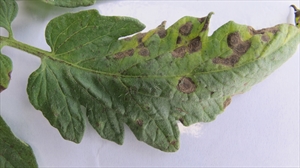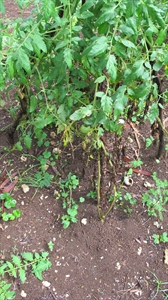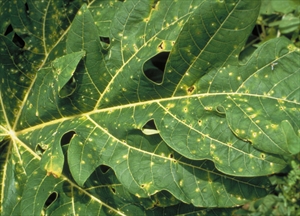Target spot, leaf spot
Pacific Pests, Pathogens, Weeds & Pesticides - Online edition
Pacific Pests, Pathogens, Weeds & Pesticides
Tomato target spot (163)
Corynespora cassiicola
Asia, Africa, North, South and Central America, the Caribbean, Europe, Oceania. It is recorded on tomato from Fiji, Niue, Samoa, Solomon Islands, Tonga, and Vanuatu.
Tomato, papaya (see Fact Sheet no. 300), cucumber (see Fact Sheet no. 189), legumes and probably weeds.
The disease starts on the older leaves and spreads upwards. The first signs are irregular-shaped spots (less than 1 mm) with a yellow margin (Photo 1). Some of the spots enlarge up to 10 mm and show characteristics rings, hence the name of 'target spot' (larger spots Photos 1&2). Spread to all leaflets and to other leaves is rapid (Photo 3), causing the leaves to turn yellow, collapse and die (Photo 4). Spots also occur on the stems. They are long and thin. Small light brown spots with dark margins may also occur on the fruit.
The spores are spread by wind-blown rain, and if windy wet weather continues for a few days, spread is fast and plants lose their leaves quickly.
The source of the fungus is from other crops, the remains of the previous crop and, perhaps, other host species. The fungus is very common on papaya leaves causing angular, light brown or grey spots, 2 mm diameter, sometimes surrounded by a yellow margin; the centres of the spots often fall out producing a 'shot-hole' effect (Photo 5). It is also a disease of cucumber (see Fact Sheet no. 189).
The fungus causes plants to lose their leaves; it is a major disease. If infection occurs before the fruit has developed, yields are low. This is a common disease on tomato in Pacific island countries. The disease occurs in the screen house and in the field.
Look for the disease on the bottom leaves. Look for tiny brown spots with yellow margins. Look for larger spots up to 10 mm that have ring patterns. Spots may be present on the stems and on the fruit.
CULTURAL CONTROL
Cultural control is important. The following should be done:
Before planting:
- Do not plant new crops next to older ones that have the disease.
- Plant as far as possible from papaya, especially if leaves have small angular spots (Photo 5).
- Check all seedlings in the nursery, and throw away any with leaf spots.
During growth:
- Remove a few branches from the lower part of the plants to allow better airflow at the base
- Remove and burn the lower leaves as soon as the disease is seen, especially after the lower fruit trusses have been picked.
- Keep plots free from weeds, as some may be hosts of the fungus.
- Do not use overhead irrigation; otherwise, it will create conditions for spore production and infection.
After harvest:
- Collect and burn as much of the crop as possible when the harvest is complete.
- Practise crop rotation, leaving 3 years before replanting tomato on the same land.
RESISTANT VARIETIES
Trials have been done in Solomon Islands with lines of tomatoes from AVRDC (now known as The World Vegetable Center). One variety has been released and this has some tolerance to the disease, BUT is not resistant. It has the number CLN2585D.
CHEMICAL CONTROL
Warm wet conditions favour the disease such that fungicides are needed to give adequate control. The products to use are chlorothalonil, copper oxychloride or mancozeb. Treatment should start when the first spots are seen and continue at 10-14-day intervals until 3-4 weeks before last harvest. It is important to spray both sides of the leaves.
____________________
When using a pesticide, always wear protective clothing and follow the instructions on the product label, such as dosage, timing of application, and pre-harvest interval. Recommendations will vary with the crop and system of cultivation. Expert advice on the most appropriate pesticide to use should always be sought from local agricultural authorities.
AUTHOR Grahame Jackson
Information from Disease management: Target spot of tomato. IPM Florida. IFAS Extension, University of Florida, (https://ipm.ifas.ufl.edu/resources/success_stories/T&PGuide/pdfs/Chapter5/Target_Spot.pdf); CABI (2020) Corynespora cassiicola (target leaf spot of tomato). Invasive Species Compendium. (https://www.cabi.org/isc/datasheet/15467); and MacLenzie KJ et al. (2018) A review of Corynespora cassiicola and its increasing relevance to tomato in Florida. APS Publications. (https://apsjournals.apsnet.org/doi/10.1094/PHP-05-18-0023-RV); and from Corynespora cassiicola (2020) Wikipedia. (https://en.wikipedia.org/wiki/Corynespora_cassiicola).
Produced with support from the Australian Centre for International Agricultural Research under project PC/2010/090: Strengthening integrated crop management research in the Pacific Islands in support of sustainable intensification of high-value crop production, implemented by the University of Queensland and the Secretariat of the Pacific Community.








